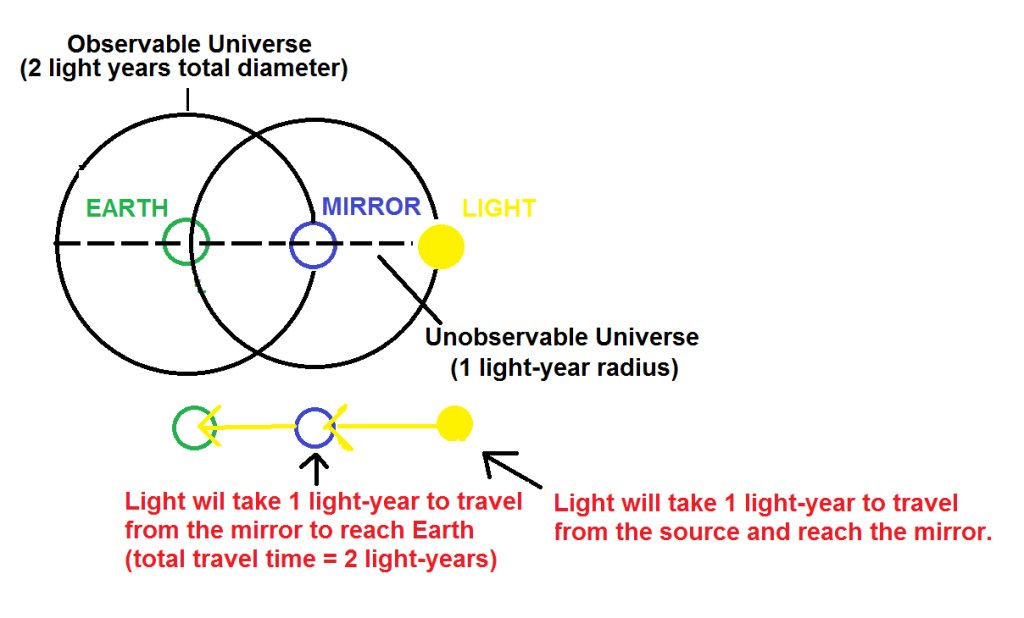

The question runs a little something like this: Assuming that we were able to get mirrors to the edge of the observable universe instantly, and position them in such a way so that light from the other side was reflected back towards Earth, would this allow us to see objects in the unobservable universe? Since we could see the mirror, couldn’t we see light from the unobservable universe in the mirror?
For example, if the mirrors were placed there 3 years ago, would they reflect 3 light-years passed the edge of the observable universe?
If they were placed there 13 billion years ago, could we see twice as far?
In order to answer the question, let me give a brief rundown of the observable universe and what it is. Roughly 13.81 billion years ago, our universe came into existence. Very shortly thereafter, primordial light started shooting across the cosmos and spreading throughout the early universe. At this juncture, the universe itself was also expanding. The inflation of the universe slowed after the first initial burst, but since then, the rate of expansion has been steadily increasing due to the influence of dark energy. Cosmologists estimate that the oldest photons that we can observe have traveled a distance of 45 billion light years since the Big Bang. That means that our observable universe is some 90 billion light years wide (give or take a few light years).
These 90 billion light years contain all of the quarks, quasars, stars, planets, nebulae, black holes—and everything else that we could possibly observe. But the observable universe only contains the light that has had time to reach us. A lot more universe exists beyond what we are able to observe. According to the theory of cosmic inflation, the entire universe’s size is at least 1023 times larger than the size of the observable universe and could be up to 1050 times larger.
So while the size of the observable universe looks like this:
93,000,000,000 light-years,
The size of the unobservable universe looks like this:
100,000,000,000,000,000,000,000,000 light-years.
Essentially, we can’t see anything anything farther away than the 90 billion light-year edge of the observable universe. But what if we could get a mirror there? Would it allow us to see more?
First, for the purposes of this question, we will assume that the light is bright enough for us to see from Earth, that nothing is going to block our view, and that the light won’t get red shifted out of existence. Now then, let’s scale things down to make it simple (take a look at the attached image for clarification on the following discussion).

The Short Answer:
The mirrors would not help. Why not? Well, in this hypothetical situation, on Earth, we are only able to see light that is 1 light-year away from us in each direction (2 light-years total diameter i.e., this makes the diameter of our observable universe 2 light-years across). However, light from the source in the unobservable universe would need to travel 1 light-year to reach the mirror, and then another light-year to be reflected off the mirror and reach Earth.
As I already said, we can only see 1 light-year in any direction. Since this light source takes 2 light-years total travel time, and we can only see things that are 1 light-year total travel time away, we will not be able to see the light in the mirror. To offer further clarification, even though (in reality) the light already hit the mirror, from our position on Earth, we won’t observe the light hitting the mirror for another light-year i.e, in the end, we are seeing the mirror and the light that it is reflecting as it appeared 1 light-year ago.
To scale things back up, in reality, we can only see 45 billion light-years in any direction, and the light would take 90 billion light-years to reach us (not factoring in the continual expansion from dark energy). So we would not be able to see light in the mirror from the unobservable universe (it would still need to travel another 45 billion light-years before the light reached us on Earth).
Thanks to Raphaël Laflamme for sending us this question.